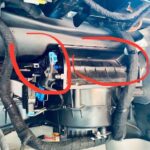VCDS (Vag-Com Diagnostic System) long term fuel trims (LTFT) are crucial data points for diagnosing engine performance issues. They represent the ECU’s (Engine Control Unit) adjustments to the fuel mixture based on feedback from the oxygen sensors. This article delves into the various factors that can influence these readings and how to interpret them using VCDS.
Factors Affecting VCDS Long Term Fuel Trims
Several components and systems can impact LTFT readings. Understanding these factors is essential for accurate diagnosis:
Exhaust System Issues
A faulty exhaust system, including leaks, incorrect oxygen sensor placement, or the use of oxygen sensor defoulers, can disrupt exhaust gas readings. This leads to inaccurate data being sent to the ECU, affecting fuel trim adjustments.
Sensor Malfunction
Beyond oxygen sensors, other components like the Mass Air Flow (MAF) sensor, fuel pressure sensor, Manifold Absolute Pressure (MAP) sensor, and even spark plugs and ignition coils can contribute to incorrect LTFT values. A malfunctioning MAF sensor, for instance, can provide erroneous air flow data, leading the ECU to miscalculate the required fuel. Similarly, issues with fuel pressure or spark delivery can disrupt combustion efficiency, impacting fuel trim. Even faulty grounds, a common problem with aftermarket components, can impact sensor readings and dwell time, leading to inaccurate LTFTs.
Identifying Sensor Banks in VCDS
When using VCDS to diagnose issues, correctly identifying sensor banks is crucial. Misinterpreting this information can lead to misdiagnosis and unnecessary repairs. Remember:
- BANK 1: Refers to the passenger side of the engine.
- BANK 2: Refers to the driver side of the engine.
The second number indicates the sensor’s position relative to the catalytic converter:
- Sensor 1: Located before the catalytic converter (pre-cat).
- Sensor 2: Located after the catalytic converter (post-cat).
For example, “Bank 2 Sensor 2” indicates the oxygen sensor located after the catalytic converter on the driver’s side of the engine.
Using Non-Flammable Sprays for Diagnostics
Non-flammable intake leak detection sprays can be valuable tools for pinpointing vacuum leaks, particularly those affecting fuel trims during warm-up. These sprays allow for safer testing compared to flammable alternatives, especially in diesel engines where runaway conditions are a concern. Introducing a non-flammable substance into a vacuum leak will cause a noticeable change in engine operation and corresponding DTCs (Diagnostic Trouble Codes) logged in VCDS, identifying the affected cylinder.
Understanding Fuel Trim Compensation
When an engine experiences a lean condition, such as from a vacuum leak, the ECU compensates by increasing fuel delivery. While this maintains engine operation, it can lead to long-term problems like carbon buildup, oil dilution, and potential damage to catalytic converters. Therefore, addressing the root cause of lean conditions is crucial.
Conclusion
Vcds Long Term Fuel Trims provide valuable insights into engine performance. By understanding the factors influencing these readings and correctly interpreting the data within VCDS, technicians and enthusiasts can accurately diagnose and resolve a wide range of engine problems. Recognizing the importance of sensor health, exhaust system integrity, and proper diagnostic techniques is essential for maintaining optimal engine performance and longevity.

